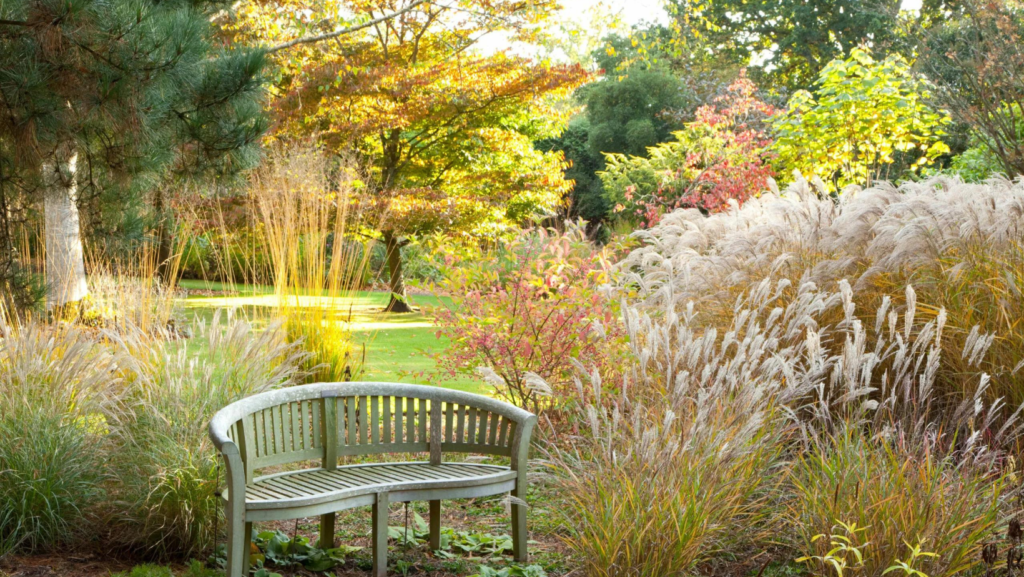Last updated on October 18th, 2024 at 04:04 am
Ornamental grasses are a beautiful addition to any lawn if you don’t have much time to maintain your lawn. Generally, ornamental grasses are low-maintenance, but they aren’t immune to winter’s harshness. Cold temperatures, frost, and snow can damage their foliage and root systems if not protected properly. Winter care ensures that your grasses not only survive but thrive when warmer months return.
Without the right seasonal maintenance, grasses may become susceptible to diseases or die back completely. Taking simple precautions can preserve their natural beauty and strength. Frost, snow, and even winter winds can lead to broken stems, root damage, and dehydration in ornamental grasses.
Different types of ornamental grasses
Ornamental grasses come in various types, each with unique characteristics and winter care needs. Here’s a table showcasing some common ornamental grass varieties:
| Grass Type | Height | Growth Habit | Winter Hardiness |
|---|---|---|---|
| Feather Reed Grass | 3-5 ft | Upright, clumping | Hardy |
| Blue Fescue | 6-12 in | Mounding | Semi-hardy |
| Maiden Grass | 4-6 ft | Arching, clumping | Hardy |
| Pampas Grass | 6-10 ft | Large, upright | Tender |
| Switchgrass | 3-6 ft | Upright, spreading | Hardy |
RELATED BLOG
- What to Plant with Maiden Grass-Top 13 Companions of Maiden Grass
Maiden Grass vs Fountain Grass-Which is Better for Your Garden - 12 Maiden Grass Landscaping Ideas for Timeless Look
Types of Ornamental Grasses
Different types of grasses require slightly different care in winter. The main division is between cool-season and warm-season grasses.
Cool-Season Grasses
Cool-season grasses, such as fescue and blue oat grass, grow actively in the cooler months and are often more tolerant of cold temperatures. However, they still benefit from winter protection.
Warm-Season Grasses
Warm-season grasses, like fountain grass and pampas grass, go dormant during the winter. These grasses are more vulnerable to frost damage and require additional attention before winter sets in.
Climate’s impact on care needs for ornamental grasses
Your local climate plays a crucial role in determining the winter care requirements for ornamental grasses.
- Average winter temperatures
- Snowfall amounts
- Wind exposure
- Frost patterns
Recognize winter challenges for ornamental grasses
Ornamental grasses face several challenges during winter months:
- Moisture loss due to dry, cold winds
- Frost heaving, which can uproot plants
- Snow accumulation causing breakage
- Rodent damage, as grasses provide shelter for small animals

How to take care of ornamental grasses in winter
Some gardeners prefer to cut their grasses back in late fall, while others leave them standing. Cutting them back can prevent disease, but leaving them standing offers some natural protection from the elements. Mulching is one of the best ways to shield your grasses from harsh winter conditions. It provides insulation for the roots and retains moisture in the soil. Mulch acts like a blanket for your plants, keeping the ground around the roots warmer and helping to prevent freezing. It also reduces water loss during cold, dry spells. Organic mulches like straw, shredded leaves, or wood chips are ideal. They decompose slowly, adding nutrients to the soil while providing winter protection.
1-Avoid fertilization during dormant periods
During winter, ornamental grasses enter a state of dormancy, and their growth slows down significantly. Fertilizing during this period can be counterproductive and potentially harmful:
- Unnecessary nutrients may lead to weak, unseasonal growth
- Excess fertilizer can burn the roots or encourage disease
- Save fertilization for spring when active growth resumes
2-Provide minimal watering when necessary
While ornamental grasses generally require less water in winter, they may still need occasional hydration:
- Water only during prolonged dry spells
- Focus on watering deeply but infrequently
- Avoid overwatering to prevent root rot
Here’s a simple guide for winter watering:
| Climate | Watering Frequency |
|---|---|
| Mild | Every 3-4 weeks |
| Cold | Only if soil is dry |
| Wet | No additional water |
3-Monitor for signs of stress or damage
Regular observation is key to maintaining healthy ornamental grasses during winter:
- Check for physical damage from snow or ice
- Look for signs of pests or diseases
- Assess overall plant health and vigor
If you notice any issues, take appropriate action promptly to prevent further damage. Remember, minimal intervention is often best during the dormant period, allowing your ornamental grasses to naturally withstand winter conditions.
Frost and Snow
Snow can actually provide some protection for ornamental grasses, while frost can be more damaging. Frost can cause the stems to become brittle and break. This is especially problematic for tall, warm-season grasses. Snow, on the other hand, insulates grasses, trapping warmth in the ground. Just make sure to gently brush off heavy snow to prevent stems from breaking under the weight.
When to Prune Ornamental Grasses
It’s best to prune cool-season grasses in late fall or early winter, while warm-season grasses should be pruned back in early spring after the threat of frost has passed. When cutting back, leave about 6-12 inches of growth to protect the base of the plant. This encourages healthy regrowth in spring. Wind can wreak havoc on ornamental grasses during winter, breaking stems and drying out roots. Consider setting up windbreaks, such as temporary fencing, or planting taller, wind-resistant plants nearby.
Ornamental grasses that are positioned in sheltered areas, like next to walls or other structures, are more likely to survive winter storms unscathed.
Rejuvenate Ornamental Grasses for Spring
As winter fades and spring approaches, it’s time to prepare your ornamental grasses for a new season of growth. Here’s how to rejuvenate your grasses and ensure they thrive in the coming months.

Adjust care routine for the new growing season
With warmer temperatures and increased sunlight, your ornamental grasses will require different care. Gradually increase watering frequency as the soil begins to dry out more quickly. Monitor your grasses closely for signs of new growth, which indicate it’s time to transition to a spring care routine.
Apply fertilizer to encourage healthy growth
Fertilizing is crucial for promoting vigorous growth in ornamental grasses. Choose a balanced, slow-release fertilizer and apply it according to the package instructions. Here’s a quick guide to fertilizer application:
| Grass Type | Fertilizer Type | Application Timing |
|---|---|---|
| Cool-season | Balanced (10-10-10) | Early spring |
| Warm-season | High nitrogen (20-5-10) | Late spring |
Prune and divide grasses as needed
Spring is the ideal time for pruning and dividing most ornamental grasses. Follow these steps:
- Cut back dead foliage to about 4-6 inches above ground level
- Remove any dead or damaged parts of the plant
- For overcrowded clumps, divide the grass into smaller sections
- Replant divided sections immediately, ensuring proper spacing
Remove winter protection at the right time
As temperatures consistently rise above freezing, it’s time to remove any winter protection you’ve applied.
- Gradually remove mulch over a period of 7-10 days
- Check for any pest or disease issues as you uncover the plants
- Ensure proper air circulation around the base of the grass





